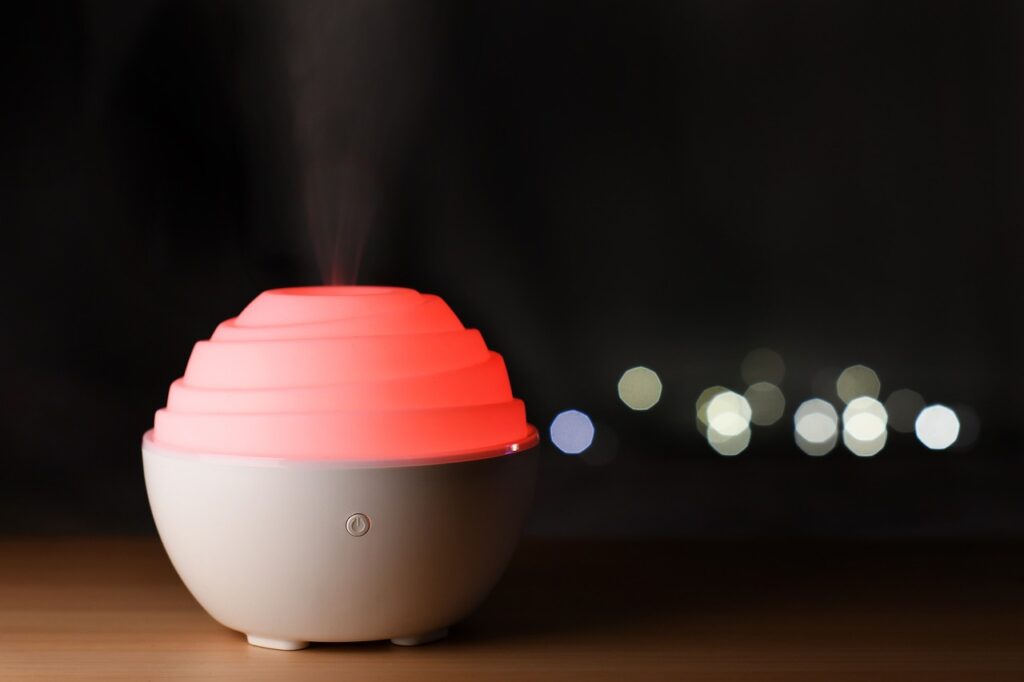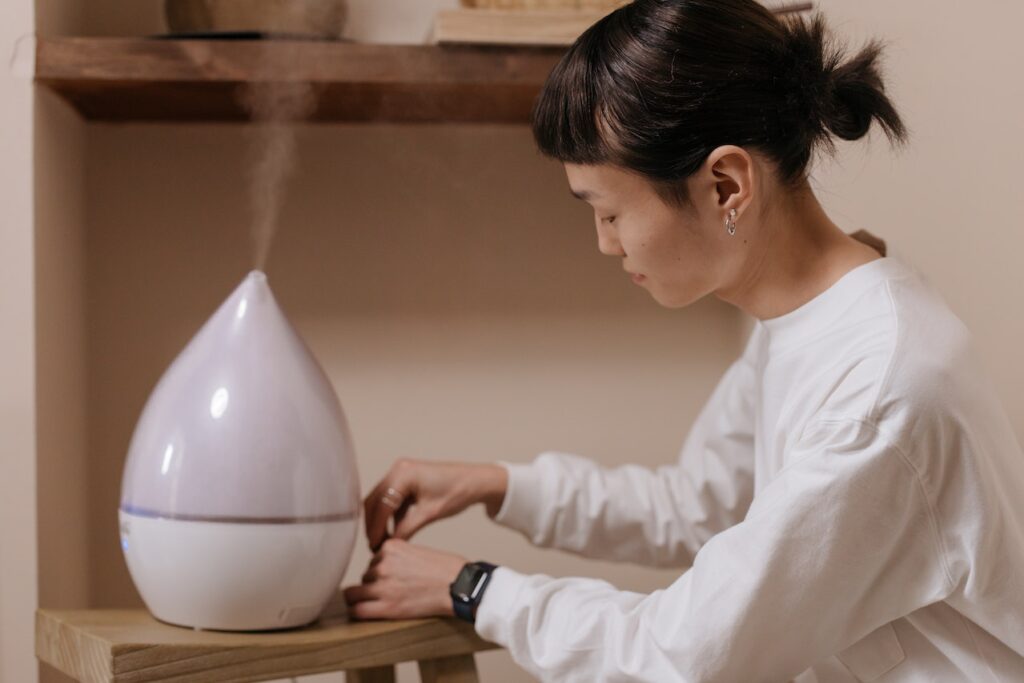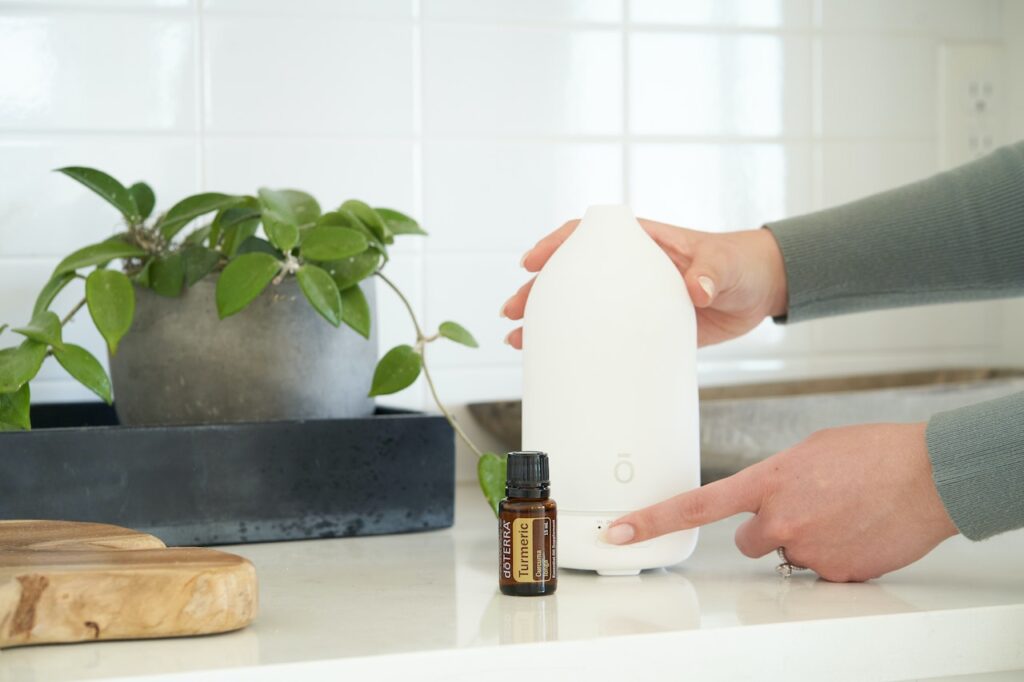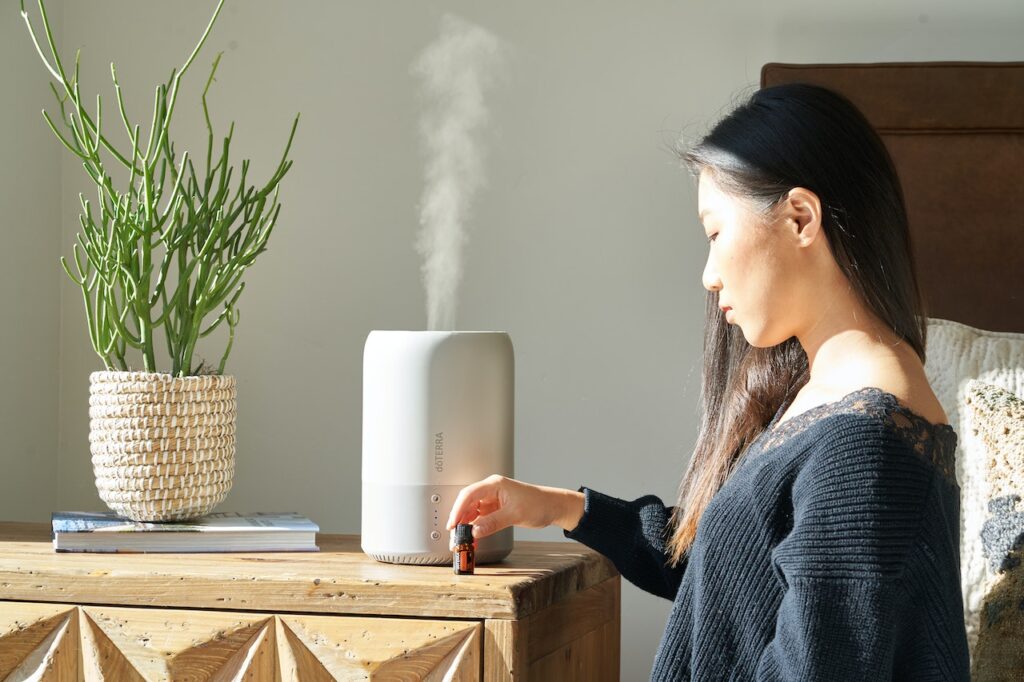Do you want to know how to clean a humidifier? You’ve come to the right place! Cleaning your humidifier is essential to maintaining it and keeping your air healthy.
For many of us, humidifiers can be a godsend in ensuring that our home air stays comfortable and suitable for breathing. They offer protection from dry indoor air while improving general health and well-being, but all the benefits come at a price. Namely, keep your humidifier clean and well-maintained to ensure it works properly.
While cleaning a humidifier may seem intimidating, this guide provides simple yet highly effective steps to clean a humidifier. So, let’s dive in!
What Exactly Is a Humidifier?

In the winter, dry air can cause problems for your health and home. That’s why keeping your air humidity levels in check with a humidifier is important. But what exactly is a humidifier, and how does it work? Let’s take a closer look.
A humidifier is an appliance that increases the moisture content of the air, making it more comfortable to breathe. Depending on the size and type of humidifier you purchase, it will use cool mist or warm mist technology to regulate the humidity in your home or office.
How Does a Humidifier Work?
Most humidifiers consist of two basic parts: a reservoir and a fan. The reservoir holds water which is then drawn into the fan by the device’s motor. As the fan circulates the air, moisture from the reservoir evaporates, increasing its humidity level. This process helps to reduce dryness in your nose and throat, allowing you to breathe more easily and sleep better at night.
It also reduces static electricity in your home and prevents damage caused by low humidity levels, such as cracking furniture or peeling wallpaper. Some high-end models also have built-in sensors that adjust accordingly when levels are too low or too high. This allows you to maintain optimal humidity levels with minimal effort.
Humidifiers can be used year-round but are especially beneficial during winter when temperatures drop, and indoor heating systems considerably reduce moisture levels.
Signs That A Humidifier Needs Cleaning

You must clean the humidifier like all appliances to keep them running efficiently. However, knowing when your device needs good scrubbing can sometimes be difficult. Here are some signs that your humidifier needs cleaning:
?Unpleasant Odors Coming from the Humidifier
If you notice an unpleasant smell coming from your humidifier, it’s likely due to bacteria buildup. This is a sign that you must clean your humidifier immediately, as any bacteria could get into the air and cause respiratory problems.
?Water That’s Cloudy or Dirty
If you’re using tap water in your humidifier, it may contain minerals that can accumulate over time in the tank and other parts of the unit. It will eventually reduce efficiency, so if you notice cloudy or dirty water in your humidifier, it’s time to clean it thoroughly.
?Excessively High Levels of Humidity
The main purpose of a humidifier is to regulate humidity levels within a specific range (usually between 30% and 50%). If humidity levels are too high, this could be a sign that your unit needs to be properly maintained or is clogged with mineral deposits.
?White Dust Around Your Home
Inhaling white dust particles can harm our health since some particles may be derived from minerals found in hard water used in our homes. If you notice white dust around your home, it may be due to a clogged filter or other issues with your humidifier that need attention immediately.
?Leaks or Drips From Your Unit
Leaks or drips from any part of the unit are never good news! It could mean an issue with one of the seals that need immediate attention. Especially if it’s coming from inside the unit itself, this could pose an even bigger risk if not fixed quickly enough.
?High Energy Bills
A dirty filter can also cause an increase in energy bills as the motor has to work harder than usual to push out moisture into the air at normal levels. Cleaning filters regularly will help ensure that they are running efficiently so that you don’t see any sudden spikes in energy costs without an explanation behind them.
?Loud Noises
Loud noises from a humidifier typically indicate something wrong with its internal mechanisms or fan blades. This could be due to clogs within its system or a buildup of dirt on its fan blades; these issues require immediate attention for the safe use of the device in the future and should always involve a thorough cleaning.
These are just a few signs that your humidifier needs cleaning. If you notice any of the signs mentioned earlier, take the time to clean and maintain your device to keep running.
How to Clean a Humidifier

Cleaning a humidifier doesn’t have to be difficult or time-consuming – follow this simple step-by-step guide, and you’ll have your device running at its best in no time! Here’s how to do it:
1: Gather the Tools
Before you begin your cleaning project, have all the essential supplies. Most often, this includes:
Water
Water is undoubtedly a powerhouse for cleaning, as you can use it to wipe down surfaces, dissolve dirt and debris, or even sanitize objects. Despite its potency, you will need more than water alone if you’re attempting to remove tough stains from materials or seeking germ-free surfaces. To get those results, you may need something stronger.
Gentle Acids
Acids are the ideal solution for deep-cleaning kitchens and bathrooms to break down grease and grime easily. Out of all acidic options, the citric acid powder is a great choice due to its mild potency yet effectiveness. However, if you don’t have access to this ingredient, distilled white vinegar or any other gentle acid will suffice too.
Hydrogen Peroxide or Bleach
Both hydrogen peroxide and bleach are extremely effective at eliminating germs and disinfecting surfaces. However, great care must be taken when using either product – especially if you have children or pets. In addition to being a powerful cleaner, these substances can also irritate if not used properly.
Scrubbing Brushes/Sponges
Pair a scrubbing brush or sponge with any of these cleaners to ensure the most effective clean. The vigorous scrubbing motion helps to remove difficult dirt and debris so your chosen cleaner can work its magic. Additionally, ensure you rinse off brush set or sponges after every use; otherwise, they may become breeding grounds for bacteria.
2: Unplug Humidifier
Cleaning your humidifier is simple, but you must be careful. Start by unplugging the humidifier from all power sources to ensure your safety. This precautionary step will prevent any possibility of electrocution while you are cleaning.
3: Disassemble the Parts
Depending on the size of your device and the degree of built-up residue, it may be necessary to deconstruct its components that come into contact with water. Most humidifiers comprise a few elements; therefore, delicately remove each one and place them on a pristine surface. Check the manual for step-by-step illustrations if you need help with how everything should reassemble back together.
4: Clean with Vinegar
White vinegar is a gentle acid that can easily break down mineral deposits and gunk. Just mix equal parts of water and white vinegar, but don’t fill your tank to the brim, so there’s room for it to combine! After leaving it be for two hours, empty the mixture and rinse until everything looks clear.
5: Disinfect with Bleach
Following the vinegar solution, giving your tank and filter an additional disinfecting procedure utilizing bleach is wise. Regularly purifying will guarantee that the mist emitted from it is free of bacteria and other impurities.
To effectively disinfect your humidifier, mix one tablespoon of bleach in a gallon of water and submerge all components for up to 30 minutes. Once finished, rinse the parts with tap water until there is no longer any residual odor from the bleach.
6: Let it Dry
After you’ve gone through washing and sanitizing your humidifier, the last step is to let it dry. Removing every last bit of remaining moisture is key for preventing mold buildup as well as any damage or rusting of its parts. And when you’re ready to use the humidifier again, just refill it with distilled water, and you’re good to go.
7: Repeat the Process
You should clean your humidifier every two to three weeks for best results. This will help prevent any buildup of bacteria and debris from inside the unit, ensuring that it runs properly and safely for as long as possible.
Following these steps, you can easily keep your humidifier clean and running efficiently for years.
How Often Should You Clean Your Humidifier
In order to get the most out of your humidifier and keep it running at its best, it’s essential to give it a good cleaning every two to three weeks. This will help prevent bacteria buildup and ensure the mist is free from contaminants.
Tips on Maintaining Your Humidifier

In addition to regular cleaning, there are some key steps you can take to maintain your humidifier and keep it running smoothly. Here are a few things to remember:
✔️Empty the Tank Every Day
One of the simplest ways to maintain your humidifier is by emptying its tank every day. This will prevent mineral deposits from building up and help improve the efficiency of your device. If you have hard water, use distilled water, as this will further reduce mineral buildup.
✔️Clean the Filter Regularly
You should regularly clean the filter in your humidifier to remove dirt, dust, and other particles that can clog it up or prevent proper airflow. Check the filter once a month and replace it when needed for optimal performance.
✔️Check for Leaks
Leaks can cause damage to both your device and your floors if not dealt with promptly. Regularly inspect all connections, hoses, and valves for signs of wear or leakage, and replace any damaged parts immediately to minimize any potential damage caused by leaking water.
✔️Keep an Eye on Humidity Levels
High humidity levels can lead to mold growth in your home, so monitoring them regularly with a hygrometer (or humidity meter) is essential. The ideal range of humidity should be between 30-50%. If levels are too high, turn off the humidifier until they drop back into this range before turning it back on again.
✔️Change Out Old Filters
Old filters can cause poor performance in your device and bad smells due to bacteria growth within them if not changed frequently enough. Be sure to change out old filters according to manufacturer instructions or every three months at minimum for best results.
✔️Check for Blockages
Blockages can occur in both tanks and hoses, restricting airflow through them, causing poor performance in your device overall, and increased energy bills due to wasted power being used to run the device with restricted airflow. Ensure that all tanks, hoses, and connections are clear of any debris before using the humidifier each time so that there aren’t any blockages present that could slow down or stop its operation entirely.
✔️Clean Often
It’s important not only after cleaning but also throughout use. Algae build up over time, even when using distilled water, so clean out any tanks thoroughly with warm soapy water at least once a month or more often if necessary, depending upon usage frequency.
✔️Use an Antimicrobial Solution
For added protection against bacterial growth within tanks or other components, you can use an approved antimicrobial solution such as bleach diluted in water (1 part bleach 2 parts water) during regular cleanings. This will help reduce the chances of bacterial growth occurring within components such as tanks.
✔️Check for Scale Buildup
Scale buildup occurs naturally over time due to minerals present within many common tap waters, so check around gaskets or other areas where scale may accumulate during regular inspections/cleanings and remove any scale present.
✔️Replace Parts When Necessary
Parts such as filters may need to be replaced more frequently than others due to wear & tear caused by normal usage, so always make sure you replace worn/damaged parts right away when necessary. Their devices run optimally after cleaning them.
✔️Check Fan Blades
Be sure to inspect fan blades periodically for signs of wear and tear, such as chips, cracks, etc., as this can affect the performance of your machine if left unchecked.
✔️Keep Away From Direct Sunlight
Direct exposure to sunlight can damage some components of certain types of humidifiers, so make sure that yours is kept away from direct sunlight when possible.
✔️Don’t Forget About Descaling
Depending on your device type, some models require descaling every few months to prevent mineral deposits from building up within its components, which can decrease efficiency over time. Descaling kits are available online (or in-store) for most major brands.
✔️Regularly Check Electrical Cords
Check electrical cords regularly for signs of fraying or other wear-and-tear, which could lead to serious safety hazards if left unnoticed.
Following these maintenance tips can help ensure that your humidifier works optimally and lasts longer.
The Benefits of a Clean Humidifier
?Cleanliness
Dirt, dust, and debris can accumulate in humidifiers over time, causing bacteria and mold growth, which can eventually be released back into your home or workplace air. By keeping your humidifier clean, you not only prevent any unwanted dirt or grime buildup but also reduce the risk of breathing in unhealthy particles.
?Improved Efficiency
A dirty filter can significantly reduce the efficiency of your humidifier by clogging up its internal parts and preventing it from working as efficiently as it should. Regular cleaning will ensure that the unit operates at its optimal level for longer periods without replacing parts too often.
?Improved Air Quality
Unclean filters can allow bacteria and other contaminants to enter the air in your home through the humidifier’s output, leading to poor air quality, which could have a negative effect on those with respiratory issues such as asthma or allergies. Keeping your humidifier clean regularly prevents this from happening and helps improve the overall air quality of your home or workplace.
?Better Comfort Levels
A well-maintained, clean humidifier provides optimum comfort levels by allowing you to adjust humidity settings according to personal preference while avoiding any unpleasant smells caused by bacteria or mold growth within the unit.
?Reduced Maintenance Cost
By taking regular care of your humidifier, you can save money on costly repairs or replacement parts due to damage caused by neglect or lack of maintenance. Regular cleaning prevents dirt buildup and keeps all internal components running smoothly, so they don’t need replacing soon.
?Increased Lifespan
Regularly cleaning your device prevents dirt buildup, which can cause damage over time and drastically reduce lifespan if not taken care of properly. Regularly cleaning out filters will ensure that they last longer than they would otherwise so that you get more use out of them before needing replacements.
?Prevention of Mold Growth
Humidifiers require regular maintenance to prevent mold growth within their systems. Not only is this unsightly, but it’s also potentially hazardous for those with respiratory issues. Cleaning out filters regularly helps keep moisture levels balanced, thus preventing mold growth.
?Odor Control
If left uncleaned, dampness inside a humidifier’s filter can cause strong odors, which may be unpleasant for some people. Cleaning out your device regularly ensures that these odors are not an issue, creating a more pleasant environment for everyone present.
?Better Sleep Quality
Humidifiers help maintain healthy humidity levels indoors during nighttime, creating a comfortable sleep environment free from dryness or allergies caused by dry indoor air. Properly maintaining your device ensures no pollutants enter the air while you sleep, providing better quality rest overall.
?Increased Energy Savings
Compared to traditional heating methods such as radiators or electric heaters, using a clean, well-maintained humidifier results in significant energy savings due to its low power consumption rates when used correctly. This makes it an ideal choice for households looking for ways to save money on their electricity bills every month.
These are just some of the reasons why keeping your humidifier clean and well-maintained is important.
Frequently Asked Questions
Can You Use Tap Water in a Humidifier?
Yes, tap water can be used in a humidifier; however, if you live in an area with hard water, consider using distilled or filtered water instead. Hard water contains minerals such as calcium and magnesium, which can build up inside the humidifier tank resulting in clogging and reduced device performance. Filtered or distilled water will help prevent this buildup and keep your humidifier running smoothly.
Should Humidifier Be On All Night?
When it comes to running your humidifier throughout the night, it depends on your specific needs. If you live in an arid climate, running it all night may be beneficial; however, if you live in an area that experiences higher levels of humidity, then running it all night may not be necessary. It’s best to consult your doctor or local air-quality specialist for advice on what’s best for your situation.
Where Is the Best Place To Put a Humidifier?
The ideal place for a humidifier is near where you spend most of your time during the day or while sleeping at night. This ensures that you are getting the maximum benefit from using it. Additionally, some experts recommend placing them away from windows and other drafts as this can reduce their efficiency.
Do Humidifiers Use A Lot Of Electricity?
No, most modern humidifiers are designed to use very little electricity, so they won’t significantly add to your monthly electricity bill.
What Are The Pros Of Having a Humidifier While Sleeping?
Sleeping with a humidifier has many benefits, such as improved air quality, which helps reduce allergies and asthma symptoms; improved skin hydration; relief from congestion due to colds or allergies; better sleep quality due to increased comfort level; and increased energy levels due to improved breathing.
Final Words
Cleaning your humidifier is simple and easy, whether you use a cool mist humidifier or a warm mist humidifier. However, always read your specific model’s cleaning instructions before attempting any maintenance. Moreover, follow this guide to help you get the most out of your humidifier so that it can provide you with years of efficient use.

